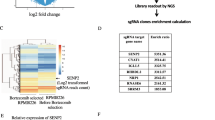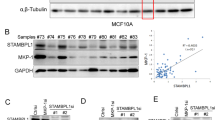Abstract
The mechanism underlying curcumin (diferuloylmethane) resistance is still largely unknown. Here we employed proteomic approach to identify the Siah-interacting protein (SIP) as a candidate for detailed study, because the spot intensity of SIP on a two-dimensional gel displayed 70–90% reduction in curcumin-sensitive cells, but remained unchanged in curcumin-resistant sublines, after curcumin treatment. Both gain- and loss-of-function studies revealed that SIP promoted curcumin-induced apoptosis. Moreover, SIP underwent phosphorylation and nuclear translocation in curcumin-sensitive but not resistant cells, upon curcumin exposure. The nuclear translocation of SIP was remarkably impaired when a putative nuclear localization sequence (NLS, amino acid (aa) 143–159) was deleted or the serine 141 was mutated into alanine, whereas truncation of the N-terminal region (aa 1–43) obviously increased the nuclear import of SIP. In accordance with their nuclear localization, N-terminal truncation significantly enhanced the proapoptotic effect of SIP, whereas NLS deletion or Ser141Ala mutation attenuated the apoptosis-promoting activity of both wild-type- and N-terminal truncated-SIP. These data suggest that SIP plays a role in apoptosis and curcumin resistance, and the function of SIP may be regulated by different motifs, such as the NLS, N-terminal region and serine 141. Our findings provide new insights into the biological significance of SIP and the mechanisms of drug resistance.
This is a preview of subscription content, access via your institution
Access options
Subscribe to this journal
Receive 50 print issues and online access
$259.00 per year
only $5.18 per issue
Buy this article
- Purchase on Springer Link
- Instant access to full article PDF
Prices may be subject to local taxes which are calculated during checkout






Similar content being viewed by others
Accession codes
References
Aggarwal BB, Shishodia S, Takada Y, Banerjee S, Newman RA, Bueso-Ramos CE et al. (2005). Curcumin suppresses the paclitaxel-induced nuclear factor-kappaB pathway in breast cancer cells and inhibits lung metastasis of human breast cancer in nude mice. Clin Cancer Res 11: 7490–7498.
Bhandarkar SS, Arbiser JL . (2007). Curcumin as an inhibitor of angiogenesis. Adv Exp Med Biol 595: 185–195.
Bhattacharya S, Lee YT, Michowski W, Jastrzebska B, Filipek A, Kuznicki J et al. (2005). The modular structure of SIP facilitates its role in stabilizing multiprotein assemblies. Biochemistry 44: 9462–9471.
Blom N, Gammeltoft S, Brunak S . (1999). Sequence and structure-based prediction of eukaryotic protein phosphorylation sites. J Mol Biol 294: 1351–1362.
Blom N, Sicheritz-Pontén T, Gupta R, Gammeltoft S, Brunak S . (2004). Prediction of post-translational glycosylation and phosphorylation of proteins from the amino acid sequence. Proteomics 4: 1633–1649.
Daouti S, Wang H, Li WH, Higgins B, Kolinsky K, Packman K et al. (2009). Characterization of a novel mitogen-activated protein kinase kinase 1/2 inhibitor with a unique mechanism of action for cancer therapy. Cancer Res 69: 1924–1932.
Dhillon N, Aggarwal BB, Newman RA, Wolff RA, Kunnumakkara AB, Abbruzzese JL et al. (2008). Phase II trial of curcumin in patients with advanced pancreatic cancer. Clin Cancer Res 14: 4491–4499.
Filipek A, Jastrzebska B, Nowotny M, Kuznicki J . (2002a). CacyBP/SIP, a calcyclin and Siah-1-interacting protein, binds EF-hand proteins of the S100 family. J Biol Chem 277: 28848–28852.
Filipek A, Jastrzebska B, Nowotny M, Kwiatkowska K, Hetman M, Surmacz L et al. (2002b). Ca2+-dependent translocation of the calcyclin-binding protein in neurons and neuroblastoma NB-2a cells. J Biol Chem 277: 21103–21109.
Filipek A, Wojda U . (1996). p30, a novel protein target of mouse calcyclin (S100A6). Biochem J 320: 585–587.
Gutcher I, Webb PR, Anderson NG . (2003). The isoform-specific regulation of apoptosis by protein kinase C. Cell Mol Life Sci 60: 1061–1070.
Hsieh HL, Schafer BW, Cox JA, Heizmann CW . (2002). S100A13 and S100A6 exhibit distinct translocation pathways in endothelial cells. J Cell Sci 115: 3149–3158.
Huang HD, Lee TY, Tzeng SW, Horng JT . (2005). KinasePhos: a web tool for identifying protein kinase-specific phosphorylation sites. Nucleic Acids Res 33: W226–229.
Iakoucheva LM, Radivojac P, Brown CJ, O'Connor TR, Sikes JG, Obradovic Z et al. (2004). The importance of intrinsic disorder for protein phosphorylation. Nucleic Acids Res 32: 1037–1049.
Jans DA, Hubner S . (1996). Regulation of protein transport to the nucleus: central role of phosphorylation. Physiol Rev 76: 651–685.
Jin T, George Fantus I, Sun J . (2008). Wnt and beyond Wnt: multiple mechanisms control the transcriptional property of beta-catenin. Cell Signal 20: 1697–1704.
Joo JH, Yoon SY, Kim JH, Paik SG, Min SR, Lim JS et al. (2008). S100A6 (calcyclin) enhances the sensitivity to apoptosis via the upregulation of caspase-3 activity in Hep3B cells. J Cell Biochem 103: 1183–1197.
Karunagaran D, Rashmi R, Kumar TR . (2005). Induction of apoptosis by curcumin and its implications for cancer therapy. Curr Cancer Drug Targets 5: 117–129.
Kawamori T, Lubet R, Steele VE, Kelloff GJ, Kaskey RB, Rao CV et al. (1999). Chemopreventive effect of curcumin, a naturally occurring anti-inflammatory agent, during the promotion/progression stages of colon cancer. Cancer Res 59: 597–601.
Kilanczyk E, Filipek S, Jastrzebska B, Filipek A . (2009). CacyBP/SIP binds ERK1/2 and affects transcriptional activity of Elk-1. Biochem Biophys Res Commun 380: 54–59.
Knauf JA, Elisei R, Mochly-Rosen D, Liron T, Chen XN, Gonsky R et al. (1999). Involvement of protein kinase cepsilon (PKCepsilon) in thyroid cell death. A truncated chimeric PKCepsilon cloned from a thyroid cancer cell line protects thyroid cells from apoptosis. J Biol Chem 274: 23414–23425.
Lange A, Mills RE, Lange CJ, Stewart M, Devine SE, Corbett AH . (2007). Classical nuclear localization signals: definition, function, and interaction with importin alpha. J Biol Chem 282: 5101–5105.
Li N, Chen X, Liao J, Yang G, Wang S, Josephson Y et al. (2002). Inhibition of 7, 12-dimethylbenz[α]anthracene (DMBA)-induced oral carcinogenesis in hamsters by tea and curcumin. Carcinogenesis 23: 1307–1313.
Lotfi K, Mansson E, Peterson C, Eriksson S, Albertioni F . (2002). Low level of mitochondrial deoxyguanosine kinase is the dominant factor in acquired resistance to 9-beta-D-arabinofuranosylguanine cytotoxicity. Biochem Biophys Res Commun 293: 1489–1496.
Mahmmoud YA . (2007). Modulation of protein kinase C by curcumin; inhibition and activation switched by calcium ions. Br J Pharmacol 150: 200–208.
Mansson E, Stridh H, Albertioni F . (2002). Resistance to mitochondrial- and Fas-mediated apoptosis in human leukemic cells with acquired resistance to 9-beta-D-arabinofuranosylguanosine. Biochem Biophys Res Commun 298: 338–344.
Matsuzawa SI, Reed JC . (2001). Siah-1, SIP, and Ebi collaborate in a novel pathway for beta-catenin degradation linked to p53 responses. Mol Cell 7: 915–926.
Nakai K, Horton P . (1999). PSORT: a program for detecting sorting signals in proteins and predicting their subcellular localization. Trends Biochem Sci 24: 34–36.
Ning X, Sun S, Hong L, Liang J, Liu L, Han S et al. (2007). Calcyclin-binding protein inhibits proliferation, tumorigenicity, and invasion of gastric cancer. Mol Cancer Res 5: 1254–1262.
O'Connor R . (2009). A review of mechanisms of circumvention and modulation of chemotherapeutic drug resistance. Curr Cancer Drug Targets 9: 273–280.
Orre LM, Pernemalm M, Lengqvist J, Lewensohn R, Lehtio J . (2007). Up-regulation, modification, and translocation of S100A6 induced by exposure to ionizing radiation revealed by proteomics profiling. Mol Cell Proteomics 6: 2122–2131.
Santelli E, Leone M, Li C, Fukushima T, Preece NE, Olson AJ et al. (2005). Structural analysis of Siah1-Siah-interacting protein interactions and insights into the assembly of an E3 ligase multiprotein complex. J Biol Chem 280: 34278–34287.
Shankar E, Sivaprasad U, Basu A . (2008). Protein kinase C epsilon confers resistance of MCF-7 cells to TRAIL by Akt-dependent activation of Hdm2 and downregulation of p53. Oncogene 27: 3957–3966.
Sharma RA, Euden SA, Platton SL, Cooke DN, Shafayat A, Hewitt HR et al. (2004). Phase I clinical trial of oral curcumin: biomarkers of systemic activity and compliance. Clin Cancer Res 10: 6847–6854.
Sun S, Ning X, Liu J, Liu L, Chen Y, Han S et al. (2007). Overexpressed CacyBP/SIP leads to the suppression of growth in renal cell carcinoma. Biochem Biophys Res Commun 356: 864–871.
Takigawa Y, Brown AM . (2008). Wnt signaling in liver cancer. Curr Drug Targets 9: 1013–1024.
Tran SE, Holmstrom TH, Ahonen M, Kahari VM, Eriksson JE . (2001). MAPK/ERK overrides the apoptotic signaling from Fas, TNF, and TRAIL receptors. J Biol Chem 276: 16484–16490.
Wang WZ, Cheng J, Luo J, Zhuang SM . (2008). Abrogation of G2/M arrest sensitizes curcumin-resistant hepatoma cells to apoptosis. FEBS Lett 582: 2689–2695.
Wu J, Tan X, Peng X, Yuan J, Qiang B . (2003). Translocation and phosphorylation of calcyclin binding protein during retinoic acid-induced neuronal differentiation of neuroblastoma SH-SY5Y cells. J Biochem Mol Biol 36: 354–358.
Wu J, Wong WW, Khosravi F, Minden MD, Penn LZ . (2004). Blocking the Raf/MEK/ERK pathway sensitizes acute myelogenous leukemia cells to lovastatin-induced apoptosis. Cancer Res 64: 6461–6468.
Yang YJ, Liu WM, Zhou JX, Cao YJ, Li J, Peng S et al. (2006). Expression and hormonal regulation of calcyclin-binding protein (CacyBP) in the mouse uterus during early pregnancy. Life Sci 78: 753–760.
Acknowledgements
This study was supported by grants from the National Natural Science Foundation of China (30470664), Ministry of Science and Technology of China (2010CB912803, 2005CB724600) and Ministry of Education of China (105136).
Author information
Authors and Affiliations
Corresponding author
Ethics declarations
Competing interests
The authors declare no conflict of interest.
Additional information
Supplementary Information accompanies the paper on the Oncogene website
Supplementary information
Rights and permissions
About this article
Cite this article
Luo, J., Yang, J., Yu, BY. et al. Identification of Siah-interacting protein as a potential regulator of apoptosis and curcumin resistance. Oncogene 29, 6357–6366 (2010). https://doi.org/10.1038/onc.2010.358
Received:
Revised:
Accepted:
Published:
Issue Date:
DOI: https://doi.org/10.1038/onc.2010.358
Keywords
This article is cited by
-
Expression and regulation of CacyBP/SIP in chronic lymphocytic leukemia cell balances of cell proliferation with apoptosis
Journal of Cancer Research and Clinical Oncology (2016)
-
The potential role of CacyBP/SIP in tumorigenesis
Tumor Biology (2016)



